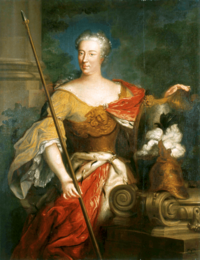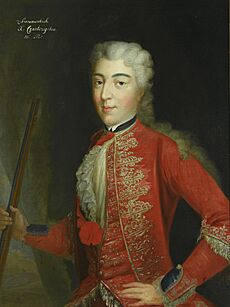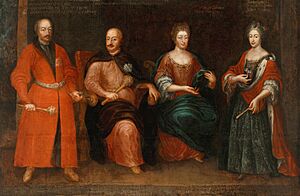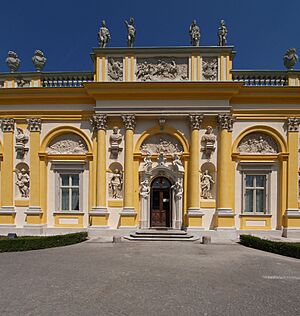Elżbieta Sieniawska facts for kids
Quick facts for kids
Elżbieta Sieniawska
|
|
|---|---|
| Grand Hetmaness of the Crown | |

Portrait of Elżbieta Sieniawska as Minerva
|
|
| Born | 1669 Końskowola, Poland |
| Died | 21 March 1729 Oleszyce, Poland |
| Noble family | Lubomirski family |
| Spouse(s) | Adam Mikołaj Sieniawski |
| Issue | Maria Zofia Czartoryska |
| Father | Stanisław Herakliusz Lubomirski |
| Mother | Zofia Opalińska |
Elżbieta Helena Sieniawska (born Lubomirska) was a very important Polish noblewoman. She was born in Końskowola in 1669 and passed away in Oleszyce on March 21, 1729. She held the title of Grand Hetmaness of the Crown, which meant she was the wife of a top military commander. Elżbieta was also famous for supporting artists and building beautiful places.
During the rule of Augustus II the Strong, she became a powerful woman in the Polish–Lithuanian Commonwealth. She played a big role in major events like the Great Northern War and a war for independence in Hungary. People thought she was the most powerful woman in the Commonwealth and even called her "the uncrowned Queen of Poland."
Contents
Biography
Early Life and Education
Elżbieta was the only child of Prince Stanisław Herakliusz Lubomirski and his first wife, Countess Zofia Opalińska. Her father was a wise man who greatly influenced her education and political ideas. When he passed away, she inherited many of his lands, including Puławy, Łubnice, and properties in Warsaw.
She went to a special boarding school in Warsaw run by the Visitationist Sisters. In 1680, she became a lady-in-waiting for Queen Marie Casimire. In 1687, she married Adam Mikołaj Sieniawski, who was the Grand Hetman of the Crown. Even though her husband wanted her to stay with him, she often stayed in Warsaw. She was very independent, especially with her money, and had to protect her property from her husband's interference. Eventually, she managed to have a balanced marriage, sometimes even showing her leadership.
A Powerful Stateswoman

Elżbieta was known for being very smart and clever. Her husband often sent her on important diplomatic missions because she was so skilled. People called her "a great ruler and the First Lady of the Republic." Even King Augustus II had her portrait among other famous women.
After King John III Sobieski died, she supported a French prince, François Louis, for the Polish throne. Later, she decided to support Augustus II instead. After Queen Marie Casimire left for Rome, Elżbieta managed her properties in Warsaw.
Between 1701 and 1703, she helped financially and politically with a rebellion in Hungary against the House of Habsburg. The leader of this rebellion, Francis II Rákóczi, who was the Prince of Transylvania, became a close ally. In the Sieniawskis' estate in Berezhany, Rákóczi announced the start of the uprising. Their connection grew during the war, and he even wrote her special letters.
In 1706, after Augustus II gave up his throne, Elżbieta helped with talks between the Russian Tsar Peter I of Russia and the Swedish King Charles XII of Sweden. She even met with King Charles XII after being taken by the Swedish Army in November 1707. She was released a month later with help from France.
After Augustus's abdication, her husband became a key player in the fight for the Polish crown. He considered becoming king himself, but Elżbieta strongly disagreed and even threatened to divorce him. She believed her ally Francis Rákóczi was the best choice for the throne during a difficult time for Poland. She worked with a French diplomat to help with peace talks. She also tried to reduce Russia's influence in the Commonwealth. She was a very active politician, making secret contacts with different groups and managing various plans.
From 1709, she supported Konstanty for the throne. Even though she didn't want Augustus II to be king again, she accepted it when he returned to power. In 1711, she invited many important people, including Tsar Peter I and King Augustus II, to the baptism of her only daughter in Jarosław. Tsar Peter I was impressed by her intelligence.
Later Life and Contributions
In her later years, Elżbieta stepped back from politics. She focused on managing her many estates and helping them grow economically. She was very strict about how her properties were run. For example, in a letter from 1726, she told an accountant to be more careful with his work.
She worked with people like Andrzej Stanisław Tucci, a priest from Końskowola, and Feyga Leybowiczowa, a Jewish woman who managed her mills and inns. Elżbieta also supported Jewish communities on her lands, even giving them permission to settle in Staszów and build a synagogue in 1718.
Elżbieta also focused on building and restoring many important places. In 1720, she added a new orangery (a type of greenhouse) to the Wilanów Palace. In 1722, she began rebuilding the Puławy Palace, and in 1730, she made the Łubnice Palace bigger. She bought Olesko, Ternopil, and the famous Wilanów Palace from the Sobieski family.
Some of her most notable building projects include a church and monastery for Capuchin friars in Lviv (finished in 1718), a wooden mansion in Oleszyce (1713), and a palace-orangery in Sieniawa (1718). She also helped rebuild the Holy Cross Parish Church in Końskowola (1724) and the Lubomirski Palace in Lublin (1725–1728). Some of these projects she did with her husband.
When Elżbieta's daughter, Maria Zofia, became a widow in 1728, her new marriage became a very important topic across Europe. Maria Zofia inherited a huge fortune from her father, including many towns and villages, and also from her husband and mother. Many powerful men wanted to marry her because she was one of the wealthiest women in Europe. Eventually, August Aleksander Czartoryski won her hand, with the support of King Augustus II.
Patronage of the Arts
Elżbieta Sieniawska had many connections across Europe, from Germany to Prague and Vienna. She used these connections to bring many famous artists to Poland. Ádám Mányoki, a court painter for Rákóczi, worked for Elżbieta in Warsaw before becoming the official painter for King Augustus II.
She hired the best artists in Poland, including architects like Giovanni Spazzio and Józef Fontana, painters like Jan Jerzy Plersch and Giuseppe Rossi, and sculptors. She also employed artists from the Dresden court, like Johann Sigmund Deybel and Louis de Silvestre. Elżbieta also supported young, talented artists, helping them get training. She was also a patron of the poet Elżbieta Drużbacka.
In 1713, King Augustus II bought a palace and started building a new one called the Saxon Palace. It was meant to be like Versailles and was the biggest building in Warsaw. At that time, palaces were often decorated to show the owner's importance and power. The king's palace facade was not very grand because most of the money went to his capital in Dresden.
Elżbieta, who also loved building, chose an old royal church, the Visitationist Church, as her main project in the capital. This church was important because it was right in front of the new royal palace. Everyone who visited the king would see Elżbieta's grand building. She hired her court architect, Karol Bay, to design a new, richly decorated facade for the church.
Her most important work in architecture was saving and improving the Wilanów Palace, which used to belong to King John III Sobieski. She decorated the palace's outside walls and gardens with her family's coat of arms and special symbols. For the inside, she hired an Italian painter, Giuseppe Rossi, who created amazing trompe-l'œil paintings (which trick the eye) and mythological scenes on the ceilings. Following the example of Queen Marie Casimire, Elżbieta had herself painted as the Roman goddess of fertility, Flora, in the Lower Vestibule.
In 1729, she started building a mausoleum in Berezhany to honor her husband, who was the last male in the Sieniawski family line. However, she passed away the same year in Oleszyce before she could finish the inside.
See also
- Marina Mniszech
- Urszula Mayerin
- Izabela Czartoryska





